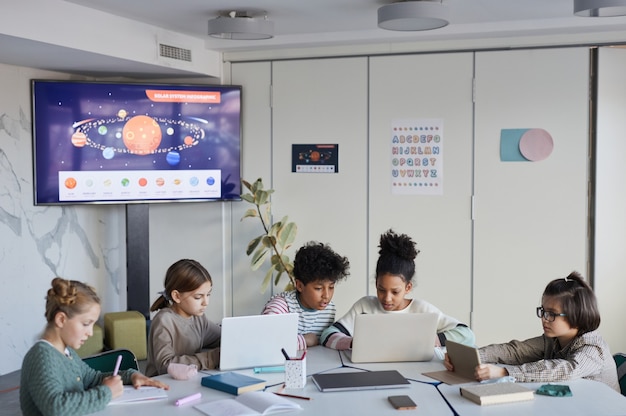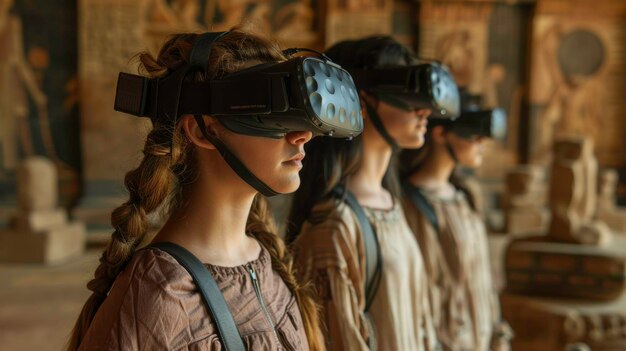Emerging Trends in EdTech: US Classrooms in the Future

AD
Emerging trends in educational technology encompass personalized learning platforms, AI-driven tools, immersive experiences like VR/AR, and adaptive assessments, all of which are increasingly being implemented in US classrooms to enhance student engagement and learning outcomes.
What are the emerging trends in educational technology and their implementation in US classrooms? The integration of technology in education is rapidly evolving, reshaping how students learn and educators teach. From personalized learning experiences to innovative assessment methods, the US education system is witnessing a significant transformation driven by advancements in educational technology.
AD
Personalized Learning Platforms
Personalized learning platforms are revolutionizing education by tailoring the learning experience to each student’s unique needs and pace. These platforms use data analytics to identify knowledge gaps and strengths, providing customized content and activities.
This approach allows for a more engaging and effective learning process, as students can focus on areas where they need the most support while still being challenged in their areas of strength. The goal is to create a learning environment that adapts to the individual, rather than forcing the individual to adapt to the environment.
AD
Benefits of Personalized Learning
Personalized learning offers numerous benefits for both students and educators.
- Increased student engagement and motivation
- Improved learning outcomes and retention
- Greater flexibility and adaptability in the learning process
- More efficient use of instructional time
By catering to individual learning styles and needs, personalized learning platforms can help students achieve their full potential. They also provide educators with valuable insights into student progress, enabling them to provide targeted support and interventions.

Artificial Intelligence (AI) in Education
Artificial intelligence is rapidly making its way into the educational landscape, offering tools that can automate administrative tasks, provide personalized tutoring, and enhance the overall learning experience.
AI-powered systems can analyze student data to identify patterns and predict areas where students may struggle, allowing educators to intervene proactively. These systems can also provide instant feedback on assignments, helping students learn from their mistakes in real-time.
AI-Driven Tutoring Systems
One of the most promising applications of AI in education is AI-driven tutoring systems. These systems can provide personalized instruction and support to students, adapting to their individual learning styles and needs.
- 24/7 availability
- Personalized feedback and guidance
- Adaptive learning paths
- Cost-effective solution for supplemental support
AI-driven tutoring systems can supplement traditional classroom instruction, providing students with extra support and personalized attention. They can also help students develop critical thinking and problem-solving skills.
In conclusion, AI’s role in education is expanding, offering tools that enhance teaching and learning while providing personalized support to students.
Virtual and Augmented Reality (VR/AR)
Virtual and augmented reality technologies are transforming education by creating immersive and engaging learning experiences. VR allows students to step into virtual environments, while AR overlays digital information onto the real world.
These technologies can bring abstract concepts to life, making learning more interactive and memorable. VR and AR can also provide students with opportunities to explore historical sites, conduct virtual experiments, and collaborate with peers in virtual environments.
Applications of VR/AR in Classrooms
VR and AR are being used in a variety of subjects, from science and history to art and language learning.
- Virtual field trips to explore historical sites and natural environments
- Interactive science simulations to conduct experiments safely
- AR apps for language learning to visualize vocabulary and grammar concepts
- Immersive storytelling experiences to engage students in literature
By providing students with hands-on, interactive experiences, VR and AR can help them develop a deeper understanding of complex concepts and improve their critical thinking skills. These technologies can also create a more engaging and enjoyable learning environment.

Online Learning Platforms for Hybrid Models
The rise of online learning platforms has paved the way for hybrid learning models, which combine traditional classroom instruction with online learning activities. These platforms offer a variety of features, including video lectures, interactive quizzes, and collaborative discussion forums.
Hybrid learning models provide students with greater flexibility and control over their learning, allowing them to learn at their own pace and on their own schedule. They also enable educators to personalize instruction and provide targeted support to students.
Benefits of Hybrid Learning Models
Hybrid learning models offer numerous benefits for both students and educators.
- Increased flexibility and convenience
- Personalized learning experiences
- Expanded access to educational resources
- Enhanced student engagement and collaboration
By combining the best of both worlds, hybrid learning models can create a more effective and engaging learning environment. They also prepare students for the demands of the 21st century workforce, where online collaboration and communication are essential skills.
In summary, with the expansion of online platforms for hybrid learning, educators are now capable of customizing instruction by providing specific support and an engaging learning atmosphere.
Adaptive Assessments and Data Analytics
Adaptive assessments use data analytics to tailor the difficulty of test questions to each student’s skill level. These assessments provide a more accurate measure of student knowledge and skills, as they adjust to the student’s performance in real-time.
Data analytics can also be used to track student progress and identify areas where students may need additional support. This information can help educators make informed decisions about instruction and intervention, ensuring that all students have the opportunity to succeed.
Advantages of Adaptive Assessments
Adaptive assessments offer several advantages over traditional standardized tests.
- More accurate measure of student knowledge and skills
- Personalized testing experience
- Reduced test anxiety
- Valuable data for instructional decision-making
By providing a more personalized and accurate assessment of student learning, adaptive assessments can help educators make more informed decisions about instruction and intervention. They can also help students develop a growth mindset, as they focus on their progress and improvement over time.
By leveraging data analytics, adaptive assessments ensure individualized support and targeted interventions, fostering student achievement.
Gamification in Education
Gamification involves incorporating game-like elements into the learning process to increase student engagement and motivation. This can include points, badges, leaderboards, and other rewards that incentivize students to participate and achieve learning goals.
Gamification can make learning more fun and engaging, helping students develop a positive attitude towards education. It can also promote collaboration and teamwork, as students work together to achieve common goals.
Examples of Gamification Techniques
Gamification techniques can be used in a variety of subjects and settings.
- Using points and badges to reward students for completing assignments
- Creating leaderboards to foster competition and collaboration
- Incorporating game-based simulations to teach complex concepts
- Developing interactive quizzes and challenges to test student knowledge
By making learning more fun and engaging, gamification can help students develop a lifelong love of learning. It can also improve their problem-solving, critical thinking, and collaboration skills.
To conclude, gamification provides an enjoyable and engaging way for students to learn, fostering a positive attitude toward education and building essential skills.
| Key Trend | Brief Description |
|---|---|
| 🎯 Personalized Learning | Tailoring education to individual student needs. |
| 🤖 AI in Education | Using AI for personalized tutoring and automation. |
| 🌍 VR/AR | Creating immersive learning experiences. |
| 🎮 Gamification | Incorporating game elements to engage students. |
Frequently Asked Questions
▼
Personalized learning tailors the educational experience to meet each student’s individual needs, preferences, and goals, ensuring a more effective and engaging learning process.
▼
AI is utilized for personalized tutoring systems, automating administrative tasks, and analyzing student data to identify learning patterns and areas needing improvement.
▼
VR and AR create immersive learning experiences, enabling virtual field trips and interactive simulations that make abstract concepts more tangible and engaging for students.
▼
Adaptive assessments adjust the difficulty of questions based on a student’s performance, providing a more accurate measure of knowledge and skills while reducing test anxiety.
▼
Gamification incorporates game-like elements into learning, such as points, badges, and leaderboards, to increase student engagement, motivation, and collaboration in educational activities.
Conclusion
The integration of emerging educational technologies into US classrooms is revolutionizing how students learn and educators teach. From personalized learning platforms and AI-driven tools to immersive VR/AR experiences and adaptive assessments, these innovations are enhancing student engagement, improving learning outcomes, and preparing students for the demands of the 21st century workforce. As technology continues to evolve, it is crucial for educators to embrace these trends and leverage them to create more effective, engaging, and equitable learning environments for all students.